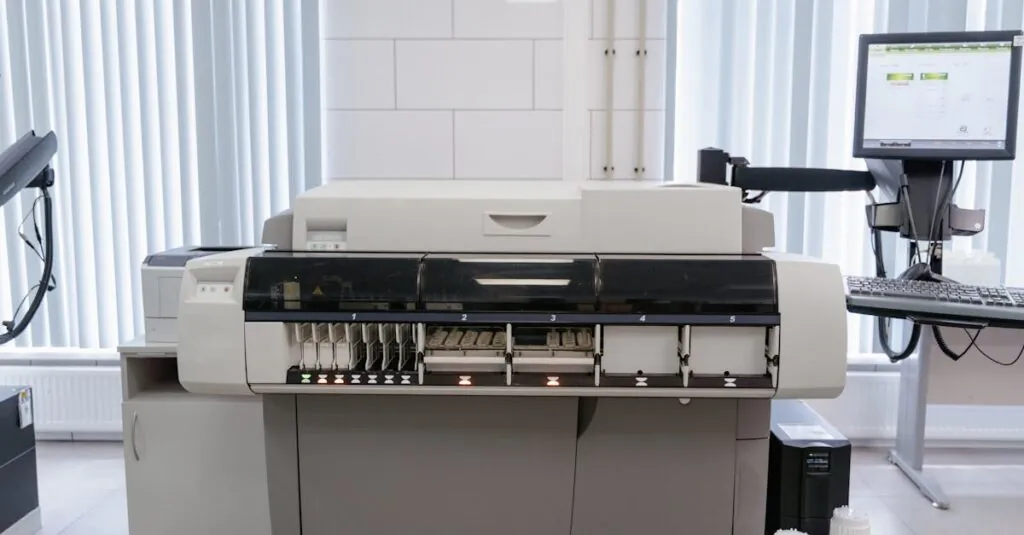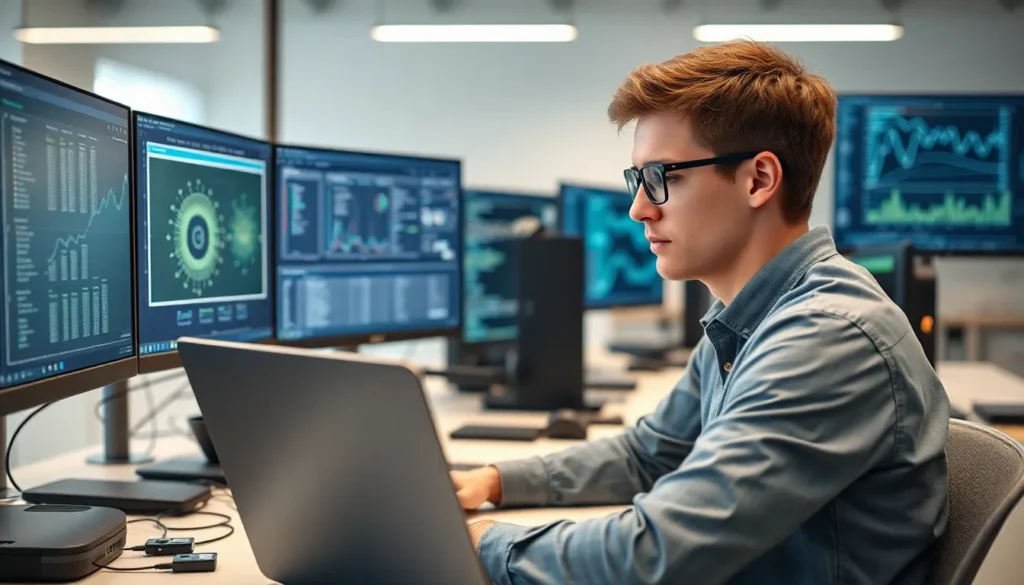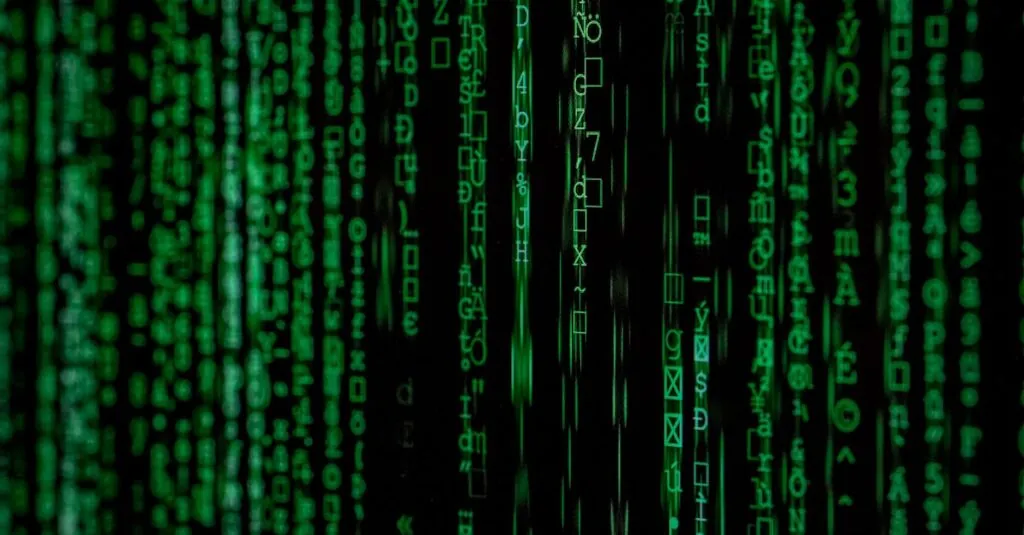Table of Contents
ToggleIn the world of 3D printing, large resin printer setups are like the superheroes of the craft. They swoop in to save the day with their ability to produce stunningly detailed models that smaller printers can only dream of. Imagine creating everything from intricate miniatures to full-scale prototypes with just a flick of a switch—it’s like having a magic wand for makers!
Understanding Large Resin Printer Setups
Large resin printer setups offer enhanced capabilities for producing intricate and detailed 3D models. These printers serve as essential tools for creators aiming to bring their designs to life.
What Is a Large Resin Printer?
A large resin printer utilizes liquid resin and UV light to create three-dimensional objects through a process called stereolithography. These printers provide high precision and detail, making them suitable for applications in industries like aerospace, automotive, and healthcare. Users favor them for their ability to produce larger prints without losing fidelity. Print size often reaches dimensions of up to 1 meter in length, accommodating substantial projects. Unlike traditional filament printers, resin printers maintain higher resolution, allowing for complex geometries and smooth finishes.
Key Components of a Setup
A large resin printer setup consists of several key components that work together to ensure successful printing. These components include the printer itself, a build plate, a resin tank, and a curing station. The printer enables the entire printing process, while the build plate serves as the surface for the final product. Resin tanks hold the liquid resin used during printing, ensuring consistent flow and application. Curing stations or UV light sources solidify the printed layers, setting the model. Each part’s quality directly impacts the final output, making careful selection essential. Proper maintenance of these components also prolongs the service life of the printer.
Benefits of Large Resin Printer Setups
Large resin printer setups offer significant advantages in various aspects of 3D printing, including print quality and operational efficiency.
High-Quality Prints
Large resin printers produce exceptional detail in prints. With their ability to render fine features, they excel at creating intricate designs and complex geometries. Precision comes from the process of stereolithography, which uses light to cure liquid resin layer by layer. Industries such as aerospace, automotive, and healthcare benefit greatly from these high-quality outputs. The capacity for larger build sizes does not compromise the detail delivered, making these printers ideal for prototypes and functional parts. Their resolution capabilities often reach below 50 microns, allowing for incredibly smooth surfaces and excellent feature representation.
Efficiency and Speed
Efficiency in large resin printers stems from their capacity to handle sizeable volumes of prints in a single build. Multiple small models can be printed simultaneously, maximizing production time. Moreover, the use of advanced curing techniques accelerates the printing process without sacrificing quality. Comparatively, they achieve larger prints faster than smaller printers due to their robust designs and optimized workflows. By reducing the overall print time, businesses can improve throughput and meet tighter deadlines. Overall, the combination of speed and efficiency enhances productivity, making large resin printers a valuable asset for any serious maker.
Challenges of Large Resin Printer Setups
Large resin printer setups present unique challenges that operators must navigate. These hurdles often influence initial investments, upkeep, and user safety.
Cost Considerations
Costs associated with large resin printers extend beyond the initial purchase price. Expenses for high-quality resin can accumulate quickly, especially with volume production. Operators may also incur costs for specialized accessories, such as curing stations and additional build plates. An estimated investment for a reliable large resin printer ranges from $2,000 to $10,000. While the potential return on investment is significant, maintaining a budget is essential to manage ongoing operating costs, including electricity and resin purchases.
Maintenance and Safety
Maintaining large resin printers requires careful attention to detail. Regular cleaning of components ensures optimal performance, while replacement of worn parts prevents malfunctions. Proper storage of resin and adherence to safety protocols minimizes health risks, as exposure to uncured resin poses dangers. Operators should use gloves and masks during handling to protect against skin contact and inhalation of fumes. Following manufacturer instructions greatly enhances safety and extends the printer’s lifespan, allowing for continued high-quality production.
Best Practices for Setting Up a Large Resin Printer
Setting up a large resin printer requires careful planning to ensure optimal results. Focusing on the key areas of space requirements and setup tips enhances the printing experience.
Space Requirements
Space availability plays a significant role in large resin printer setups. Allocating at least 2 square meters provides adequate room for the printer, build plate, and resin tank. Ensure the workspace is well-ventilated since resin fumes can be harmful. In addition, consider sturdy surfaces that can sustain the weight of the printer and equipment. Proximity to electrical outlets simplifies power access for operating the printer and curing stations. Lastly, keep the area organized to avoid accidents and ensure easy access to tools and materials.
Setup and Calibration Tips
Proper setup and calibration are critical for achieving high-quality prints. Start by leveling the build plate according to the manufacturer’s guidelines. Adjust the height to ensure even exposure during printing. Next, perform a test print to observe any alignment issues. It’s important to inspect the resin tank for any debris or residue before beginning. Regularly check the UV light source as its intensity directly impacts print quality. Always follow specific calibration instructions provided by the manufacturer to avoid common pitfalls. Adjust settings like layer thickness based on the intricacies of the design for improved precision. Continuously monitor the printing process to catch problems early.
Conclusion
Large resin printer setups represent a significant advancement in 3D printing technology. Their ability to produce high-quality, detailed prints makes them invaluable in various industries. While the initial investment and ongoing maintenance can be daunting, the benefits often outweigh the challenges for serious makers and professionals.
By prioritizing careful planning and adhering to best practices, operators can maximize the potential of their large resin printers. With the right setup and attention to detail, these printers can become powerful tools that transform creative ideas into tangible reality. Embracing this technology opens up new possibilities for innovation and design, making it an exciting time for those in the 3D printing community.




